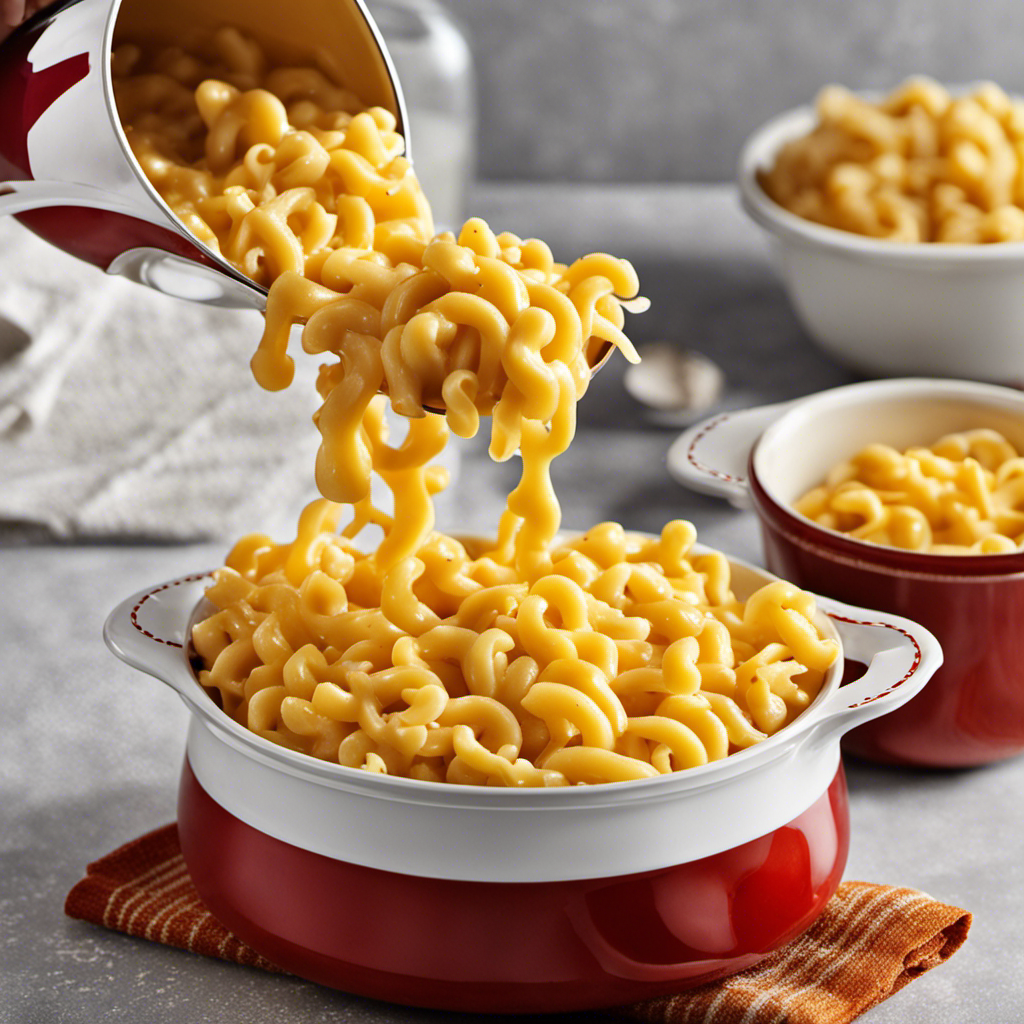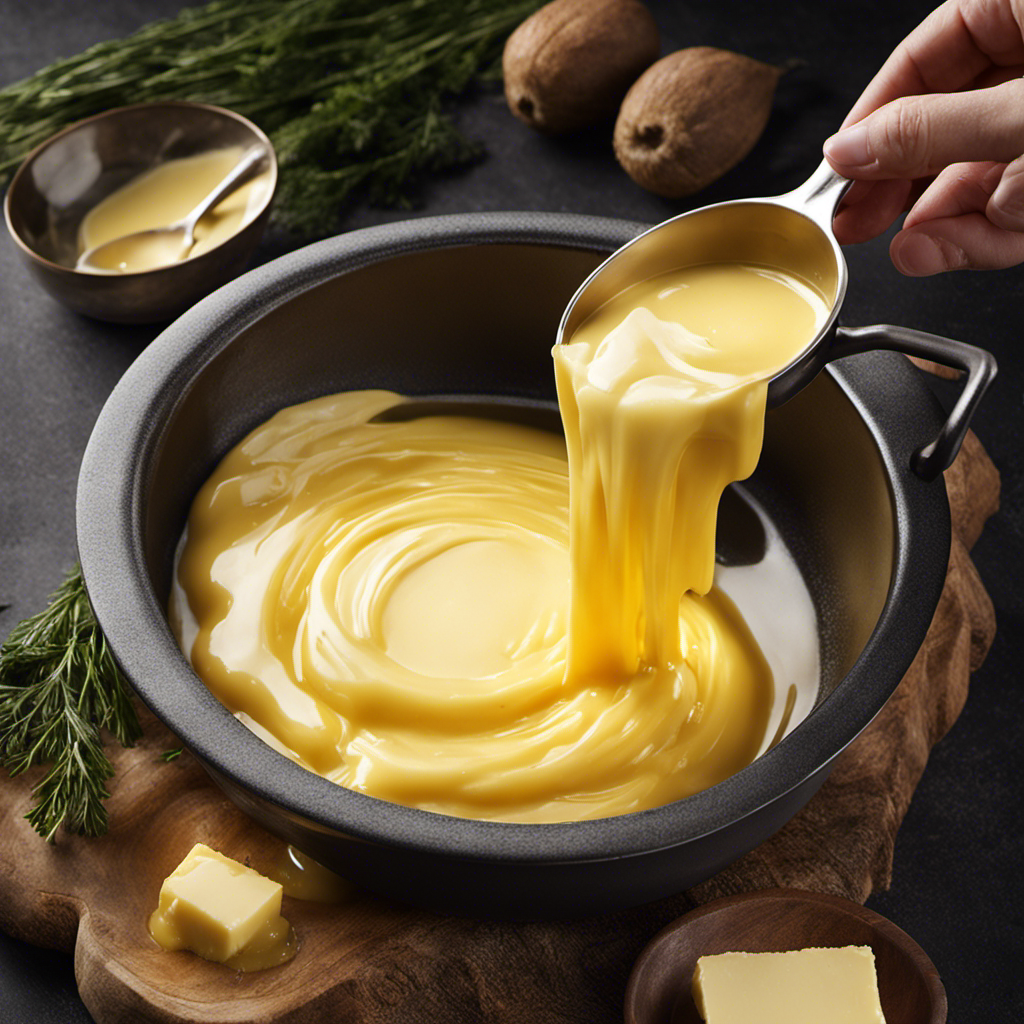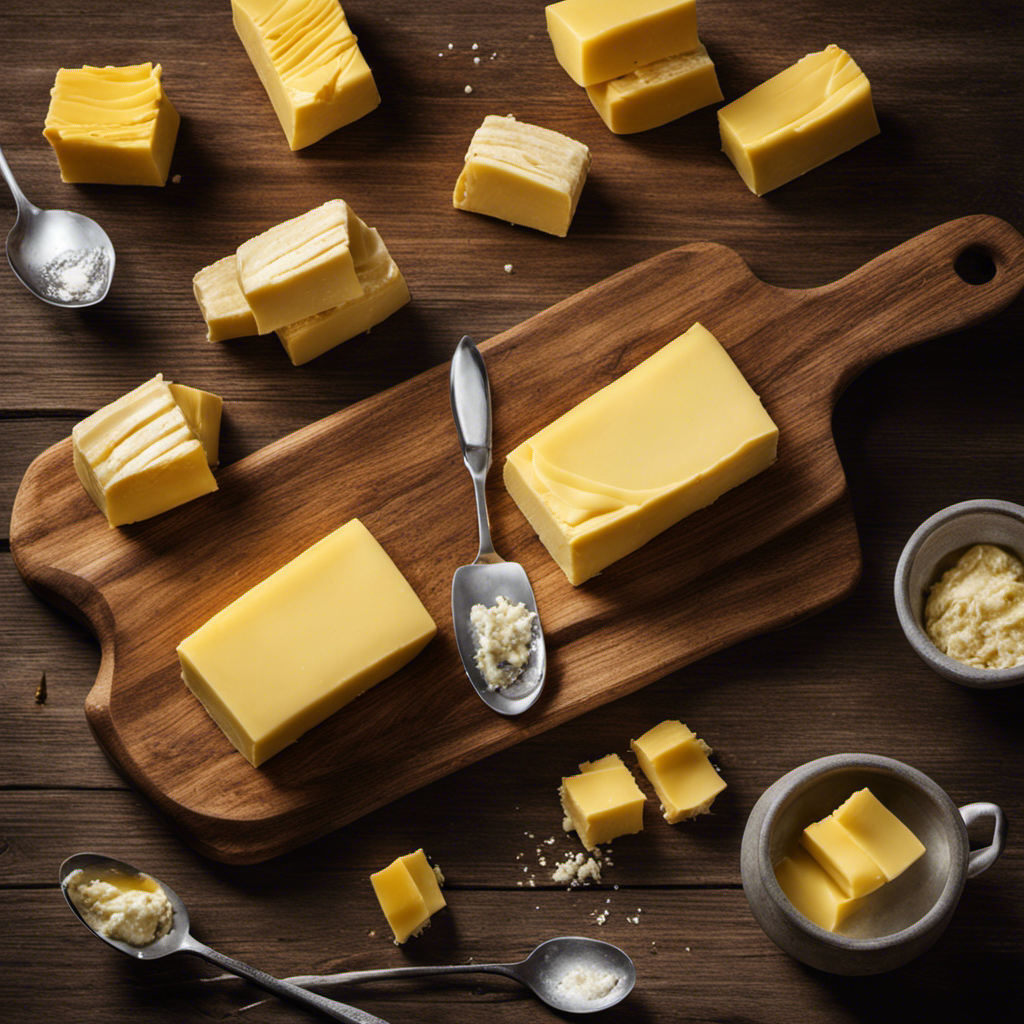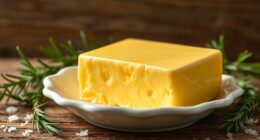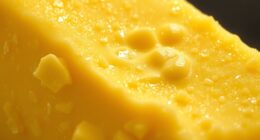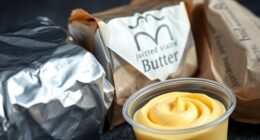I adore treating myself to a delicious bowl of creamy, cheesy Kraft Mac and Cheese.
But what if I told you it’s possible to make this scrumptious dish without using any butter? Yes, you heard that right!
In this article, I will guide you through the process of creating a velvety, butter-free version of your favorite mac and cheese.
Get ready to savor every bite of this delectable comfort food, guilt-free.
Let’s dive into the world of butterless mac and cheese!
Key Takeaways
- Margarine, olive oil, coconut oil, and Greek yogurt can be used as substitutes for butter in Kraft Mac and Cheese.
- Ingredient substitutions allow for a delicious and nutritious butter-free mac and cheese.
- Greek yogurt and coconut milk provide creamy alternatives to butter.
- Sprinkling garlic powder, black pepper, smoked paprika, or dried herbs can enhance the flavor of butterless Kraft Mac and Cheese.
Ingredient Substitutions for Butter in Kraft Mac and Cheese
If you’re out of butter, you can use margarine as a substitute in Kraft Mac and Cheese. But if you’re looking for other ingredient alternatives, there are a few options to consider.
One option is using olive oil instead of butter. It adds a rich, savory flavor to the dish and provides health benefits such as being high in monounsaturated fats.
Another alternative is using coconut oil, which gives the mac and cheese a subtle tropical taste and has potential health benefits like aiding in digestion and boosting the immune system.
Finally, you could try using Greek yogurt as a replacement for butter. It adds creaminess to the dish and offers health benefits like being high in protein.
With these ingredient substitutions, you can still enjoy a delicious and nutritious bowl of butter-free Kraft Mac and Cheese.
Now, let’s move on to the step-by-step instructions for making it.
Step-by-Step Instructions for Butter-Free Kraft Mac and Cheese
To prepare your butter-free version of Kraft mac and cheese, start by boiling the pasta according to the package instructions. While the pasta is cooking, gather your ingredient alternatives for butter. Here is a table that showcases some options:
| Ingredient | Quantity | Purpose |
|---|---|---|
| Olive oil | 2 tablespoons | Adds richness |
| Greek yogurt | 1/4 cup | Creaminess |
| Coconut milk | 1/4 cup | Creaminess |
| Avocado | 1 | Creaminess |
| Nutritional yeast | 2 tablespoons | Adds cheesy flavor |
Once the pasta is cooked, drain it and return it to the pot. Add the olive oil, Greek yogurt, coconut milk, avocado, and nutritional yeast to the pot. Stir everything together until the ingredients are well combined and the pasta is coated in the creamy mixture. Adjust the cooking time as needed to ensure that the sauce is heated through. And there you have it, a delicious butter-free version of Kraft mac and cheese!
Now, let’s move on to the next section where I will share some tips for achieving creaminess in Kraft mac and cheese without using butter.
Tips for Achieving Creaminess in Kraft Mac and Cheese Without Butter
For a creamy alternative, you can try using Greek yogurt or coconut milk in your Kraft mac and cheese recipe. These alternative cheese options not only add creaminess, but they also provide a dairy-free option for those with dietary restrictions or preferences.
Greek yogurt can be used as a substitute for butter, as it has a tangy flavor that complements the cheesy sauce. Simply mix in a few tablespoons of Greek yogurt at the end of cooking to achieve a creamy texture.
Coconut milk, on the other hand, adds a rich and nutty flavor to the mac and cheese. It can be used in place of milk or butter, and it adds a unique twist to the classic dish.
Both of these options provide a delicious alternative for those looking to enjoy Kraft mac and cheese without butter or dairy.
Flavor Enhancements for Butterless Kraft Mac and Cheese
Adding a sprinkle of garlic powder and a pinch of black pepper can enhance the flavor of your creamy mac and cheese. But why stop there? There are plenty of other seasoning options and cheese alternatives you can try to take your butterless Kraft mac and cheese to the next level.
Here are some ideas to get you started:
-
Seasoning options:
-
Smoked paprika for a hint of smokiness
-
Dried herbs like thyme or oregano for a touch of freshness
-
A dash of cayenne pepper for a spicy kick
-
Cheese alternatives:
-
Sharp cheddar for a robust and tangy taste
-
Gruyere for a nutty and slightly sweet flavor
-
Parmesan for a salty and savory kick
By experimenting with different seasonings and cheeses, you can create a unique mac and cheese experience that suits your taste buds.
Now, let’s move on to some serving suggestions for your butter-free Kraft mac and cheese.
Serving Suggestions for Butter-Free Kraft Mac and Cheese
Now let’s explore some ideas for serving your delicious butter-free Kraft mac and cheese.
While the absence of butter may seem like a challenge, there are plenty of alternative toppings that can enhance the flavor and add a nutritional boost to your dish.
One option is to sprinkle some grated Parmesan cheese on top of the mac and cheese. This adds a salty and tangy flavor that complements the creamy pasta.
Another alternative is to mix in some sautéed vegetables like spinach or broccoli. Not only do these vegetables provide added nutrients, but they also bring a vibrant color and texture to the dish.
Lastly, you can try adding some roasted chicken or grilled shrimp for a protein-packed meal. These alternative toppings not only elevate the taste but also increase the nutritional value of your butter-free Kraft mac and cheese.
Frequently Asked Questions
Can I Use Margarine Instead of Butter in Kraft Mac and Cheese?
Sure, you can use margarine instead of butter in Kraft mac and cheese. Margarine is a common alternative to butter and will still provide a creamy and flavorful result.
Can I Use Olive Oil Instead of Butter in Kraft Mac and Cheese?
Yes, olive oil can be used instead of butter in Kraft Mac and Cheese. It adds a rich and flavorful taste, while also providing health benefits such as being high in monounsaturated fats.
Can I Use Vegetable Oil Instead of Butter in Kraft Mac and Cheese?
Using vegetable oil instead of butter in Kraft Mac and Cheese is a viable alternative. It adds a subtle richness and smoothness to the dish without overpowering the flavors.
Can I Use Coconut Oil Instead of Butter in Kraft Mac and Cheese?
Sure, you can use coconut oil instead of butter in Kraft Mac and Cheese. Coconut oil adds a unique flavor and has several health benefits. It’s a great option for those looking for a dairy-free alternative.
Can I Use Chicken Broth Instead of Butter in Kraft Mac and Cheese?
I’ve tried chicken broth instead of butter in mac and cheese, and it adds a savory twist. It’s a creamy alternative that enhances the flavor. Just pour it in while cooking the noodles, and enjoy!
Conclusion
In conclusion, making Kraft Mac and Cheese without butter is a simple and delicious alternative for those who are looking to reduce their butter intake or have dietary restrictions. By using ingredient substitutions and following step-by-step instructions, you can still achieve a creamy and flavorful mac and cheese without butter.
One interesting statistic to note is that according to a survey conducted by Kraft, 30% of their customers have expressed interest in butter-free options, showing a growing demand for healthier alternatives.
So, don’t hesitate to try this butterless version and enjoy a guilt-free bowl of mac and cheese!
